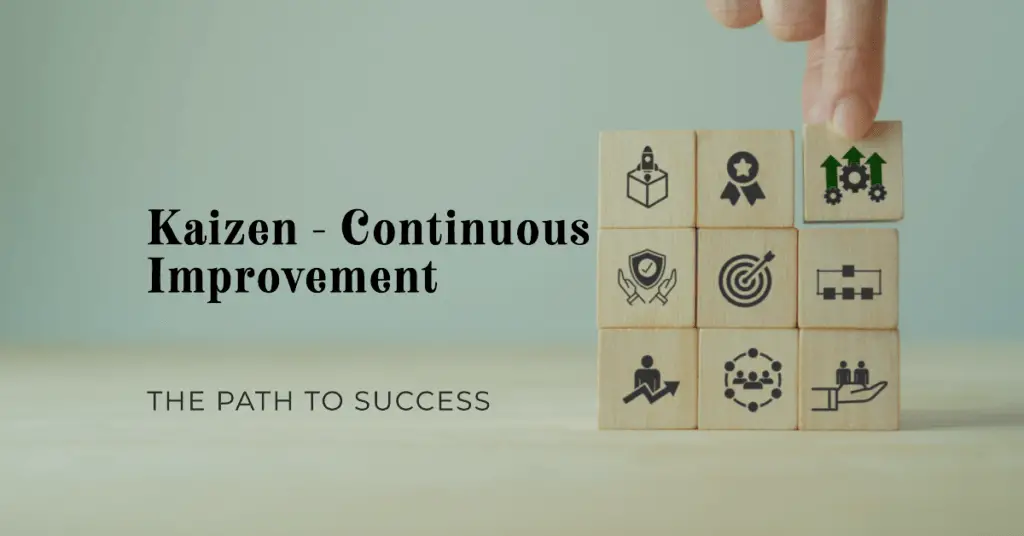Kaizen Principles: Key to Continuous Improvement and Excellence

Do you ever feel like your life or work is stuck in a rut? You’re not alone.
We all have times when we wish we could make big changes, but don’t know where to start. That’s where Kaizen principles come in – a philosophy that advocates for continuous improvement through small, incremental steps.
Kaizen is a Japanese term that means “change for the better.” It’s about making progress by taking small steps every day, rather than waiting for a major breakthrough. This approach can be applied to everything from personal development to business operations.
Definition of Kaizen Principles
At its core, Kaizen is based on the idea that small improvements made consistently over time can lead to significant positive change. These improvements can be made by anyone at any level within an organization or individual’s life.
The principles of Kaizen focus on eliminating waste and inefficiency, improving quality and safety standards, and empowering employees to contribute their ideas for continuous improvement. The goal is to create a culture of constant improvement where everyone feels empowered to make positive changes.
Brief History and Origin
Kaizen principles were originally developed in Japan after World War II as part of the country’s effort to rebuild its economy and infrastructure. The concept was first introduced by American business advisor W. Edwards Deming, who was invited by Japanese companies to help improve their production processes.
The Japanese embraced Deming’s ideas wholeheartedly and built upon them, creating their own unique approach based on teamwork and respect for individuals. Today, Kaizen has become a global phenomenon with applications across industries and sectors around the world.
The success of Kaizen principles has been due in part because it emphasizes participation at all levels of an organization – leadership must lead from the front by setting achievable goals; while employees must contribute their ideas freely without fear of retribution. What sets Kaizen apart from other improvement methodologies is that it encourages small, incremental changes instead of massive overhauls.
This means that progress can be made without disrupting the overall flow of work. With an emphasis on teamwork, problem-solving and a drive for continual improvement, Kaizen principles have become a powerful tool for organizations seeking to enhance quality and efficiency while minimizing waste and cost.
The 5S’s of Kaizen: A Foundation for Continuous Improvement
Sort: Eliminating Unnecessary Items
The first step in implementing the 5S’s of Kaizen is to sort through everything in the workplace. This includes tools, materials, equipment, and documents.
The goal is to identify and eliminate anything that is not essential to the work being done. This can include items that are broken, outdated, or simply not used on a regular basis.
Sorting through everything in the workplace can be a daunting task, but it is an essential part of creating a more efficient and productive environment. It requires careful consideration of what is truly necessary for the work being done and what can be safely eliminated without impacting productivity.
By eliminating unnecessary items, employees are able to focus more fully on their work without distractions or clutter getting in the way. This helps to improve productivity and reduce waste.
Set in Order: Organizing Remaining Items for Efficiency
Once unnecessary items have been eliminated, it’s time to organize what remains. This involves creating a designated place for everything so that it can be easily found when needed.
Tools and materials should be stored in logical locations based on how frequently they are used. Organizing remaining items also involves labeling storage areas so that everyone knows where things belong.
This helps to prevent confusion and ensures that tools and materials are returned to their proper locations after use. By organizing remaining items for efficiency, employees are able to find what they need quickly and easily without wasting time searching for tools or materials.
Shine: Cleaning and Maintaining the Workplace
The third step in implementing the 5S’s of Kaizen is shining or cleaning the workplace. This involves removing dirt, dust, debris, and other contaminants from all surfaces including floors, walls, equipment, tools etc. Keeping the workplace clean and well-maintained promotes safety, improves morale, and reduces the risk of accidents or injuries.
It also helps to prolong the life of equipment and tools by preventing rust, corrosion, and other types of damage. Regular cleaning and maintenance is essential in creating a safe, healthy, and productive work environment.
Standardize: Establishing Procedures and Guidelines for Consistency
The fourth step in implementing the 5S’s of Kaizen is standardizing procedures and guidelines. This involves establishing clear protocols for how work is done including when tasks are performed, who performs them, how they are performed etc.
By establishing standards for consistency in work processes across all employees doing a particular task or project fewer errors occur. Standardized procedures help improve work quality while reducing variability.
Standardization helps to ensure that everyone is on the same page when it comes to how things should be done. This reduces confusion and miscommunication while promoting productivity.
Sustain: Continuously Improving and Maintaining the Workplace
The fifth step in implementing the 5S’s of Kaizen is sustaining improvements. This involves continuously improving and maintaining the workplace through ongoing efforts that build on previous successes.
Through regular audits / checkups any decline in performance can be detected early enough to take corrective action before it leads to major problems. Employees should be encouraged to continuously improve their work area by suggesting ideas or coming up with new solutions that make their job more efficient or easier
Continuous improvement ensures that progress continues over time rather than stagnating after initial implementation of changes. By continuously striving for improvement employees learn better ways to get things done efficiently thus enabling them provide a better output quality over time too.
Implementing the 5S’s of Kaizen can help create a more efficient workplace by eliminating unnecessary items (Sort), organizing what remains (Set in Order), cleaning (Shine), establishing protocols (Standardize) and continuously improving (Sustain). By following these simple principles, employees can improve productivity, reduce waste and create a safer, healthier work environment.
The Importance of Continuous Improvement in Kaizen Principles
Kaizen principles are based on the belief that continuous improvement is necessary to keep a business successful. In fact, continuous improvement is one of the core values of Kaizen.
The idea behind continuous improvement is that small improvements made on a regular basis can add up to significant changes over time. Continuous improvement is also important because it helps companies stay competitive.
When businesses fail to improve, they risk falling behind their competitors and losing market share. By continuously improving, businesses can stay ahead of their competition and attract more customers.
The PDCA (Plan, Do, Check, Act) Cycle
The PDCA cycle is a tool used in Kaizen principles to help companies plan and implement continuous improvements. The cycle consists of four steps: Plan, Do, Check, and Act.
The first step of the PDCA cycle is Plan. In this step, companies identify areas for improvement and develop plans to make those improvements.
The second step is Do. This is where the plans are put into action and changes are made.
The third step is Check. During this step, companies measure the results of their actions to see if they achieved their goals.
In the Act step, companies determine what worked well and what didn’t during the previous three steps. They then use this information to make further improvements.
Examples of Continuous Improvement in Various Industries
Continuous improvement can be applied in any industry or business sector. Here are some examples: In manufacturing industries such as automotive or electronics manufacturing plants use Kaizen principles to continuously improve production processes by reducing waste, increasing efficiency, eliminating defects or reducing waiting times between processes.
Customer service industries may track customer feedback surveys using Net Promoter Score (NPS) metrics with regular review cycles for customer experience opportunities for new ways they could serve their customers better Retail industries use Kaizen principles to improve the customer experience for shoppers by improving store layout and design, enhancing marketing campaigns, and expanding product lines.
In the healthcare industry, continuous improvement is applied to reduce medical errors and improve patient outcomes. For example, hospitals may use Kaizen principles to improve communication between healthcare providers or reduce wait times for testing or treatments.
Continuous improvement can be applied in any industry or business sector. By continuously improving processes and procedures, businesses can stay ahead of their competitors and keep their customers satisfied.
Respect for People
Kaizen principles are not just about improving processes, but also about respecting people. In fact, respect for people is one of the main pillars of Kaizen. This means that employees are not just cogs in a machine, but rather they are valued members of an organization who can contribute to the improvement efforts.
Importance of respect for people in Kaizen principles
In a workplace where employees feel respected and valued, they are more likely to be motivated and engaged in their work. This leads to higher productivity, better quality output and a more positive work environment. Respect for people is also important because it fosters a culture of continuous improvement and innovation.
In order to truly embody the Kaizen principles, organizations must prioritize employee well-being and growth. By investing in employee development programs and providing opportunities for advancement within the company, organizations can ensure that employees feel valued and motivated to contribute to the success of the company.
Empowering employees to contribute to improvement efforts
One way that organizations can show respect for their employees is by empowering them to take an active role in improvement efforts. This means giving them tools and resources needed to identify inefficiencies or issues within their area of work and coming up with solutions that can be implemented.
Employees should feel comfortable sharing their ideas with management without fear of retribution or dismissal. By creating an environment where all ideas are welcome regardless of rank or position, companies can foster a culture of collaboration and innovation.
Building a culture of trust and collaboration
Another important aspect of respect for people is building trust within teams across different levels in an organization. Management must lead by example by being transparent about decision-making processes while seeking opinions from team members before making any changes.
It’s also important that management fosters collaboration among teams so that everyone has access to information necessary for making informed decisions. This can lead to improved communication, better teamwork, and ultimately better results.
Creating a culture of trust and collaboration requires active participation from management and employees alike. It’s important to listen actively, communicate clearly, and show respect for everyone’s opinion.
Kaizen Principles
Respect for people is a fundamental principle of Kaizen. Organizations must prioritize the well-being and development of their employees in order to truly embody these principles. Empowering employees to contribute to improvement efforts while building a culture of trust and collaboration is essential for creating a positive work environment where everyone feels valued and motivated to contribute to the success of the company.
Just-in-Time Production
The Definition
Just-in-Time (JIT) production is a manufacturing philosophy that aims to reduce waste and improve efficiency by producing only what is needed, when it is needed, and in the amount needed. JIT production requires a well-coordinated supply chain and an efficient production process to ensure that materials are available exactly when they are required for each step in the manufacturing process.
The Importance
JIT production is a central aspect of Kaizen principles because it eliminates waste and leads to improved productivity. By producing just what is needed, companies can avoid overproduction, reduce lead times, minimize inventory carrying costs, improve inventory accuracy, and eliminate the risk of obsolete inventory. Additionally, JIT emphasizes the importance of quality control throughout the entire production process.
Efficient Production Processes
To achieve successful JIT production, companies need to have efficient production processes in place that minimize waste at every step of the process. This includes optimizing machine setup times, reducing changeover times between product runs, and minimizing downtime due to equipment failures or maintenance requirements. Companies must also ensure that they have accurate forecasting methods in place to predict demand so that they can adjust their production schedules accordingly.
Reducing Waste
JIT production relies on a pull system where products are manufactured only when there is demand for them from customers rather than pushing products into inventory before they are sold. This reduces waste from overproduction because companies are only producing what customers need at any given time. JIT also eliminates waste from excess inventory by only having materials on hand as needed for immediate use.
Potential Challenges
Implementing JIT production can be challenging because it requires significant coordination among suppliers and across departments within an organization. Additionally, if demand fluctuates significantly or unexpectedly for any reason (such as a pandemic or natural disaster), JIT production can be difficult to maintain because it is so dependent on accurate forecasting.
Companies must also ensure that they have contingency plans in place to address any supply chain disruptions that may occur. JIT production is an important aspect of Kaizen principles because it helps companies reduce waste and improve efficiency.
By producing only what is needed, when it is needed, and in the amount needed, companies can avoid overproduction and minimize inventory carrying costs while improving quality control throughout the entire manufacturing process. While implementing JIT production can be challenging, the benefits are significant for those who are able to do so successfully.
Quality Control Circles (QCC)
Kaizen principles are all about continuous improvement, and Quality Control Circles (QCCs) are one of the most important tools for achieving this goal. A QCC is a group of employees who gather regularly to identify and solve problems in the workplace.
These groups typically consist of between three and ten members, and they are often led by a supervisor or manager. One of the key benefits of using QCCs is that they encourage employee involvement in problem-solving initiatives.
By involving employees at all levels of the organization in these efforts, companies can tap into their collective knowledge and experience to identify new opportunities for improvement. This can lead to more innovative solutions, as well as greater buy-in from employees who feel invested in the success of these initiatives.
Definition and importance in Kaizen principles
At its core, a QCC is a team-based approach to problem-solving that emphasizes collaboration and continuous improvement. These groups typically meet on a regular basis to discuss issues related to quality control, safety, productivity, or other areas where improvements could be made.
Members work together to analyze data, identify root causes, brainstorm potential solutions, and implement these solutions on a trial basis. One reason why QCCs are so important in Kaizen principles is that they help establish a culture of continuous improvement throughout an organization.
By giving employees the tools and resources they need to take ownership over their work processes, companies can create an environment where everyone is encouraged to seek out opportunities for improvement. This not only leads to better results overall but also fosters a sense of pride among employees who feel like they’re contributing meaningfully to their company’s success.
Encouraging employee involvement in problem-solving initiatives
Another benefit of using QCCs is that they help foster greater employee engagement by giving them more control over their work environment. When we empower employees to identify and solve problems on their own, they feel more invested in the success of these initiatives. They are more likely to take ownership over their work processes. This can lead to a greater sense of job satisfaction, as well as improved morale and productivity.
To encourage employee involvement in QCCs, it’s important to create a supportive environment where everyone feels comfortable sharing their ideas and opinions. This is accomplished by providing training and resources to team members, setting clear goals for improvement, and recognizing the contributions of individual members.
By creating a sense of camaraderie and shared purpose among team members, companies can build a stronger culture of collaboration that supports ongoing improvement over time. Quality Control Circles (QCCs) are an essential tool for organizations that want to embrace Kaizen principles and foster a culture of continuous improvement.
By encouraging employee involvement in problem-solving initiatives, companies can tap into the collective knowledge and experience of their employees to identify new opportunities for growth and innovation. With the right support systems in place, QCCs can drive meaningful change throughout an organization. This while also improving morale, productivity, and overall job satisfaction among employees.
Conclusion
Throughout this article, we have explored the fundamental Kaizen principles that drive continuous improvement and productivity in various industries. The concept of Kaizen was born in Japan after World War II. The 5S’s of Kaizen are Sort, Set in Order, Shine, Standardize and Sustain.
This methodology advocates eliminating clutter and waste to create a more efficient workflow. Continuous improvement is also essential to the success of Kaizen principles.
Through the PDCA cycle (Plan, Do, Check, Act), businesses can continuously improve their processes to reach optimal performance levels. Respect for people is another critical component of Kaizen principles.
By empowering employees to be involved in problem-solving initiatives and encouraging collaboration between team members, businesses can foster an atmosphere of trust and respect that leads to higher productivity levels. Just-in-Time Production (JIT) is also crucial to achieving efficiency under the Kaizen principle system.
JIT aims for businesses to receive goods only as they are needed in the production process. By reducing waste through efficient production processes, JIT helps businesses gain a competitive advantage over rivals while maintaining high-quality standards.
Quality Control Circles (QCC) provide employees with opportunities to collaborate on finding solutions to specific problems within their company or department. QCCs encourage teamwork among colleagues who may not typically work together regularly.
Adopting Kaizen principles can help companies achieve optimal efficiency by reducing waste and encouraging continuous improvement.






